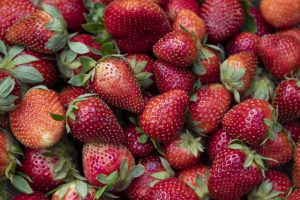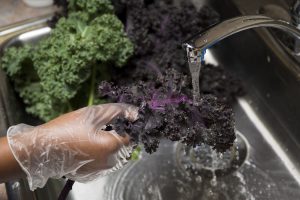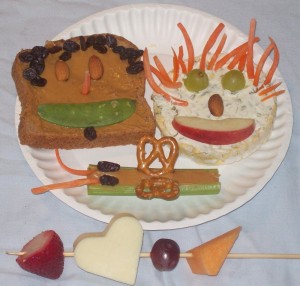
by Dorothy C. Lee | Mar 26, 2020

Strawberries from Fresh off the Farm event. Taken 04-12-2019 (Photo Source: UF/IFAS Camila Guillen)
Choose locally- grown strawberries during the harvesting season; they will be the freshest and the most flavorful. When picking strawberries, try to pick early in the morning or later in the day when the fruit is cool. Strawberries are best used within 2-3 days of picking.
Uses & Preparation
Freezing Whole Strawberries; Spread a single layer of prepared fruit on shallow trays and freeze. When frozen, promptly package (to avoid freezer burn) and return to freezer. The fruit pieces remain loose and can be used as needed.
Freezing Sliced or Crushed Strawberries; Prepare berries: Using ripe berries, wash gently and remove caps. Slice or crush partially or completely. To 1 quart berries add 3/4 cup sugar. Mix thoroughly. Stir until most of the sugar is dissolved or let stand 15 minutes. Pack into containers, leaving 1/2″ headspace. Seal and freeze.
Storage
Sort and remove any bruised or damaged berries as soon as possible and use in sauces, purees or jams. Place the berries in cool, well-ventilated containers. The moisture content of fresh strawberries is high, so store them unwashed and uncovered, or loosely covered.
Quantities
1 pint = about 3 1/4 cups whole berries (12-36 depending on size of berries) or about 2 1/4 cups sliced berries. 1 cup sliced fresh berries = One 10-oz. pkg frozen, sweetened berries.
MERRY FRESH STRAWBERRY PIE
1 9- inch pie crust, baked
1 cup white sugar
3 tablespoons strawberry flavored gelatin mix
2 tablespoons cornstarch
¼ teaspoon salt
1cup boiling water
2 pints strawberries, cleaned and stemmed
2 cups whipped topping (optional)
Combine sugar, gelatin, cornstarch, and salt in a medium saucepan. Stir in boiling water. Boil mixture for 3 minutes over high heat, stirring constantly. Cool completely.
Arrange whole strawberries in pastry shell. Pour gelatin mixture over berries. Chill before serving. Top with whipped topping, if desired.
Nutrition Information: Low in calories – High in Vitamin C – Good source of folate, potassium & fiber
Available Fresh: April – May
To learn about fresh Florida strawberries, please read our fact sheet: Panhandle Produce Pointers – Strawberries.
.For more delicious produce preparation tips, please visit: http://www.panhandleproducepointers.com.

by Melanie Taylor | Mar 11, 2020
This month brings awareness and education about the importance of our kidneys in maintaining a healthy life. Kidney function is unique because you may not notice the symptoms until the function is already far gone. The CDC reports chronic kidney disease is a condition that 1 in every 7 adults (age 18 or older) in the United States has, as well as people with end stage renal disease who need dialysis or a kidney transplant.
How do your kidneys keep you healthy?
- Help remove excess fluid levels in the body.
- Make vitamins that control growth.
- Activate Vitamin D for healthy bones.
- Filter wastes from the blood.
- Control the production of red blood cells.
- Release hormones that help regulate blood pressure.
- Help regulate blood pressure, red blood cells, and the amount of certain nutrients in the body, such as calcium and potassium.
There are many complications associated with kidney disease. They include cardiovascular disease, nerve damage, heart attack, weak bones, high blood pressure, stroke, anemia/low red blood cell count and of course kidney failure.

Speak openly with your doctor about any concerns you may have regarding your health. (Photo source: Tyler Jones, UF/IFAS)
The main risk factors for kidney disease and the problems associated with it are high blood pressure, diabetes, family history, and being 60 years old and above. Out of these four problems, two of them – high blood pressure and diabetes – may be managed by maintaining a healthy lifestyle, taking medications as prescribed, regular visits to your doctor and exercise. If you have been diagnosed with either of these two, you need to regularly monitor your blood pressure and glucose levels, take medications if prescribed, and speak openly with your doctor about concerns or questions you may have. Family history and being over the age of 60 are not issues you can control, but you can strive to live a healthy lifestyle and regularly have blood work drawn so your doctor can help catch any issues that are becoming a problem. Learning to maintain and follow your doctor’s orders will go a long way to keeping you and your kidneys healthy longer.
What are the symptoms you may notice if you are experiencing kidney problems?
- Swelling in your face, hands, abdomen, ankles, and feet.
- Blood in your urine or foamy urine.
- Puffy eyes.
- Difficult, painful urination.
- Increased thirst.
- Fatigue.
If you notice any of these problems or are just concerned because of family history, your family doctor can order the blood work to check your kidney function. If you find out you are experiencing kidney problems you should see a nephrologist – a kidney specialist.
Although many people ignore the importance of their kidneys, they play a very important part in our daily bodily functions in regulating minerals, fluids, blood pressure, and so much more. Striving to maintain a healthy lifestyle will help to ensure your kidneys keep working hard for you. Be sure to show your kidneys some love this March to celebrate National Kidney Month.
Sources:
National Kidney Foundation – https://www.kidney.org/
Center for Disease and Prevention – https://www.cdc.gov/

by Dorothy C. Lee | Mar 3, 2020
Spring showers not only bring flowers, but beautiful fresh produce from the garden.
March in National Nutrition Month. Celebrate with nutritious delicious GREENS.

Be sure to carefully wash greens before preparing to ensure a safe and delicious product. (Photo source: Tyler Jones, UF/IFAS)
The dark leafy vegetable we refer to as “greens” range from earthy to peppery in flavor. Collard greens, mustard greens, turnip greens, and kale are often grouped together because of their texture, pronounced flavor, and general uses. They actually come from several vegetable families. In general, these tart greens are cooked before eating. The season for some varieties peak November through March.
Choose leafy greens with fresh full leaves. Avoid greens that are brown, yellow spotted, wilted, or have slimy leaves. Wash greens before use. Cut stems from leafy greens before cooking. Sauté collard greens with garlic, onions, and tomatoes a little bit of olive oil. Simmer greens in low-sodium chicken broth until greens are wilted and tender. Store greens in a plastic bag in the refrigerator for two to five days.
NUTRITION TIPS: A 1/4 cup of cooked greens is about the size of one cupped handful.
Beans and Greens
1 can white kidney beans or cannellini beans rinsed and drained
1 tablespoon olive oil
1/2 cup diced onion
2 cloves garlic, minced
2 pounds fresh kale, stemmed and chopped into large pieces
Salt and pepper to taste
Sauté onion and garlic in olive oil. Add greens to the skillet. Sprinkle with 2 tablespoon of water. Cook, tossing often, until greens are bright green and slightly wilted. Remove from heat. Drain and heat beans and add to green mixture. Toss mixture, season and serve. Serves four; 1 cup serving
Savory Greens
3 cups water
1/4 pound skinless turkey breast
1/2 cup chopped onions
2 cloves garlic, crushed
1/4 teaspoon cayenne pepper
1/4 teaspoon ground cloves
1/2 teaspoon dried thyme
1 green ground ginger
2 pounds mixed greens (collards, turnips, mustard, and kale)
Place all ingredients except greens into large pot and bring to a boil. Wash greens and remove stems. Chop greens into small pieces and add to stock. Cook 20 to 30 minutes until tender. Serves six; 1 cup serving
NUTRITION INFORMATION: Cooked greens are excellent sources of Vitamins A, C, K, and Calcium.
AVAILABLE FRESH: March – June & October – December
To learn about fresh Florida greens, please read our fact sheet: Panhandle Produce Pointers – Greens.
For more delicious produce preparation tips, please visit: http://www.panhandleproducepointers.com.

by Dorothy C. Lee | Feb 3, 2020
February is National Heart Health Awareness Month. On February 7th join the nation and wear red to show support and awareness for women and heart disease.
National Heart Awareness Month is sponsored by the American Heart Association. It is designed to provide the public with information that could lead to a more healthful lifestyle and reduce heart disease.

Go Red for Women’s Heart Health
Photo Source: Dorothy Lee
The Centers for Disease Control and Prevention estimates that 610,000 people die of heart disease in the United States yearly. According to the American Heart Association heart disease and stroke kills one in three women yearly in the United States. Heart disease is a silent killer. It often strikes without warning.
Know the risk factors and symptoms of heart disease. Risk factors are family history of heart disease, diabetes, poor diet, high blood pressure and cholesterol levels, excessive alcohol use, smoking and physical inactivity.
The diet choices we make today are important to our nutritional well-being tomorrow. A diet low in saturated fat and cholesterol, high in fruits and vegetables, and grain products that contain some type of dietary fiber may reduce the risk of heart disease.
Our health is our most precious possession. A healthy diet is only one part of a heart healthy lifestyle. Physical activity is another important component. The American Heart Association physical activity guidelines recommend some type of aerobic exercise daily. Walking, dancing, biking, swimming, or gardening are good examples. Be sure to consult your physician before starting any exercise program.
We are all concerned about maintaining good health. Take steps to a healthier heart. Develop good eating habits based on moderation and variety, plus physical activity can help keep and even improve your health. So, reach in the back of the closet and find that little red dress and wear it this year on Friday, February 7th in support of Women’s Heart Healthy Awareness. Go Red!
Resource: www.heart.org
For further information, contact:
Dorothy C. Lee, C.F.C.S.
UF/IFAS Extension Escambia County
3740 Stefani Road
Cantonment, FL 32533-7792
(850) 475-5230
dclee@ufl.edu

by Angela Hinkle | Jan 24, 2020
My favorite time – snack time! For February, National Snack Food Month, let’s celebrate these tasty morsels for a whole month.
Go Beyond the Snack Aisle
Snacks often have a bad reputation, at least in terms of health. It’s true that snack food aisles are often filled with high fat, high calorie, high sodium, and high sugar choices. But snacks can be great sources of fiber, vitamins, minerals, proteins, and healthier fats and carbohydrates. You may just have to wander to other parts of the store next time you shop.
Think Mini Meal
When you snack, think of it as a mini meal. Though you could plan tomorrow’s dinner to be a plate of snack cakes with a side of potato chips, hopefully you come up with something more satisfying than that – both in taste and nutrition. Additionally, when we snack on healthier foods in between meals, it gives our bodies the sustainable energy it needs to make it to that next meal.

Snacks – Fun, Tasty, and Healthy
Photo Source: Angela Hinkle
Snack MyPlate
Try snacking from all five food groups this month.
- Whole grains – popcorn, granola, whole grain crackers
- Fruits – apples, bananas, oranges, raisins
- Veggies – pea pods, cucumber slices, carrots
- Dairy – string cheese, yogurt cups, individual shelf stable cartons of milk
- Protein – hard-boiled eggs, mixed nuts, healthy beef jerky
Make Homemade Mixed-Up Food Group Snacks
- Whole grain pita or multi-colored pepper slices dipped in guacamole or hummus
- Apple slices or carrots with peanut butter dip
- Cherry tomatoes with mozzarella and basil
- Fruit smoothies or protein shakes
- Yogurt with granola and mixed berries
- Banana Sushi – smear a whole wheat tortilla with peanut butter, put a banana in the middle, roll it up, then cut it into “sushi” slices
For more great snacking ideas, check out 10 Snack Tips for Parents, MyPlate Snack Tips for Kids, and 25 Healthy Snacks for Kids
Delicious, healthy, on-the-go snacks. Be creative and keep it healthy this February – National Snack Food month.

by Samantha Kennedy | Jan 13, 2020

A delicious cup of hot tea is a great way to start the day and can provide a daily dose of health-promoting antioxidants.
(Photo source: Samantha Kennedy)
For me, there’s nothing better than a hot cup of tea on a chilly morning – or any morning, really. The rich flavor and fragrant steam work together to perk me up and help me get ready to take on the day. And in the evening, a nice, warm cup of tea can also help me relax before settling down to sleep. The key is finding the right kind of tea for the task.
Types of Tea
There are five major types of tea: green, black, white, red, and herbal. All non-herbal teas are produced from the leaves of the warm-weather evergreen tea plant, Camellia sinensis. The degree of processing or oxidation of the leaves determines which type of tea is produced.
Green tea is very minimally processed and the leaves are not oxidized, which results in its light green color and delicate taste. Green tea is very low in caffeine. Green tea is very popular in Asian cultures, but has gained increased popularity around the world.
Black tea has a very rich flavor and the highest caffeine levels of all types of tea due to the long processing time. The leaves are fully oxidized, resulting in the rich amber color and rich flavor. Some of the most popular and common types of black tea are Early Grey, English Breakfast, and Darjeeling.
Red tea is oxidized for less time than black tea, resulting in a milder flavor and lighter color. The flavor intensity and caffeine levels of red tea fall somewhere between green and black tea. The most common type of red tea is Oolong, which is very popular in Asia.
White tea is produced from young tea leaves and unopened buds. The resulting brew has a velvety, delicate flavor and very light, “white” color. Since it is so minimally processed, it has very little caffeine.
Herbal tea is not produced from the leaves of the tea plant. Instead, herbal teas are created through a combination of herbs and other plants, often utilizing the leaves, stems, and roots. Herbal tea does not have caffeine and is often used medicinally to treat a variety of ailments.
Potential Health Benefits
The health benefits of tea, especially green tea, have long been touted. The fermentation process involved in green tea production increases the levels of a type of antioxidants called polyphenols, which can help reduce cell damage caused by the byproducts of regular cell production in the body.
According to two Harvard School of Public Health studies, those who drank tea regularly showed a decreased risk of developing Type 2 diabetes compared to non-tea drinkers. The substances in tea, such as polyphenols, have also been linked to lower risk of cardiovascular disease, cancer, and stroke and have been shown to help lower blood pressure and cholesterol.
One note of caution: Some chemicals in tea are known to bind to iron, thereby decreasing its absorption in the body. Those who suffer from iron-deficiency anemia may want to consult a physician before increasing their tea consumption.
Tea drinking is not a cure-all. However, drinking tea as part of an overall healthy diet may provide added health benefits that can help promote healthy cells and blood vessels.
So take the time to smell (and sip and savor) the tea while toasting to better health. Happy brewing!
Additional Resources:
Health benefits linked to drinking tea (Harvard Medical School)
Tea: A cup of good health? (Harvard Medical School)
Take Time for Tea: For Health and Well-being (North Dakota State Extension)
Extension classes are open to everyone regardless of race, creed, color, religion, age, disability, sex, sexual orientation, marital status, national origin, political opinions or affiliations.












